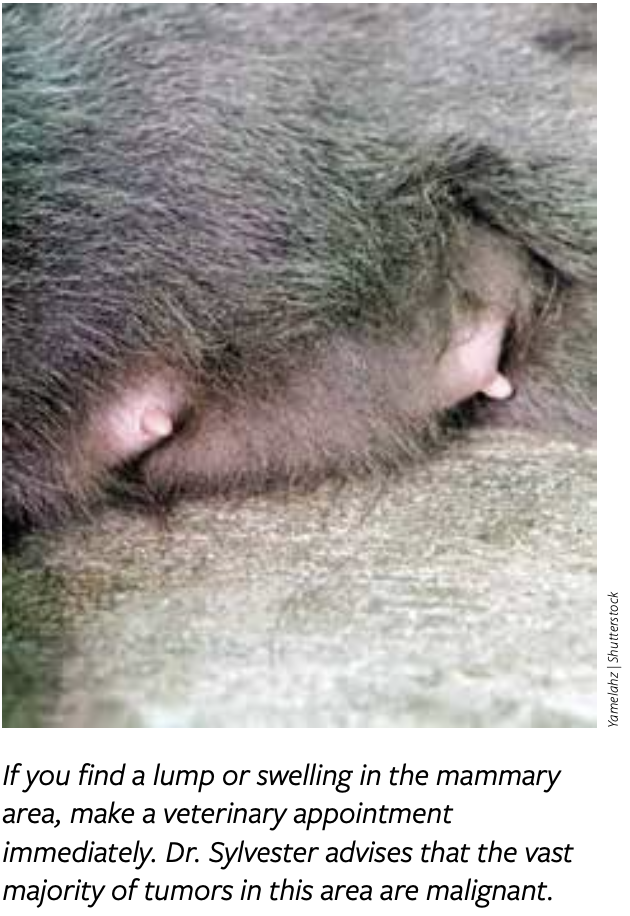Feline mammary cancer is a serious disease. It may not initially look bad to you because it starts as a tiny pea-sized lump near a nipple, and you may feel like it can just be removed and be done. Not so fast. That little lump has a high probability of being malignant, and may have already spread to surrounding breast tissue or even the lungs by the time it is found. Treatment needs to be swift and aggressive to prolong life.
“Simple lumpectomy is not recommended for mammary cancer in cats, as 85% to 90% of feline mammary tumors are malignant,” says Dr. Skylar Sylvester, assistant clinical professor, section of medical oncology at Cornell College of Veterinary Medicine. “Performing a mastectomy has been shown to improve the disease-free interval (how long cats live cancer free) compared to more conservative surgery.”
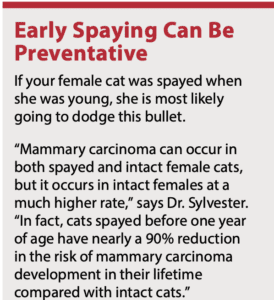 An article published in the Journal of the American Veterinary Medical Association agrees, concluding that bilateral mastectomy for the treatment of mammary adenocarcinoma in cats improved the progression-free and disease-specific survival time (J Am Vet Med Assoc 2018; 252: 1393-1402). Adenocarcinoma is the most common breast tumor in cats.
An article published in the Journal of the American Veterinary Medical Association agrees, concluding that bilateral mastectomy for the treatment of mammary adenocarcinoma in cats improved the progression-free and disease-specific survival time (J Am Vet Med Assoc 2018; 252: 1393-1402). Adenocarcinoma is the most common breast tumor in cats.
What to Expect
If a tumor is found, the cancer will be staged, just like human cancer. “Preliminary staging for mammary carcinoma involves physical exam to measure the tumor and nearby lymph nodes, thoracic radiographs (chest x-rays) to look for evidence of cancer spread to the lungs, and abdominal ultrasound (sonogram) to evaluate for spread to the internal organs or inguinal (groin) or axillary (arm pit) lymph nodes that drain the mammary tissue,” says Dr. Sylvester. “If any lymph nodes are enlarged, then we recommend fine-needle aspirate and cytology to look for metastasis (cancer spread). Bloodwork is also performed at this time to assess overall systemic health for cancer treatment.”
Surgery is no small undertaking and not a decision to take lightly. Having some idea about what to expect will help you make informed decisions for your beloved feline. Consider these details:
Bilateral mastectomy in cats can result in significant post-operative pain and discomfort. Fortunately, there have been huge advancements made in feline pain management.
Some cats are not candidates to have both chains removed at once, depending on their weight and body conformation. These cats will need to have two staged procedures, with one chain removed in an initial procedure, and the other removed in a second procedure weeks later.
Potential post-op complications include infection, incisional failure (dehiscence), fluid accumulation (seroma), and abdominal wall hernia.
Prognosis
“Survival depends on multiple factors such as size of the tumor and stage of the disease (spread to the lymph nodes or other organs),” says Dr. Sylvester. “Tumor size has been shown to have the greatest impact, so it’s important for cats to have regular vet exams to find these tumors as early as possible, while they are still relatively small.”
“On average, cats survive one to three years or more after bilateral mastectomy with early-stage disease,” says Dr. Sylvester. “However, cats whose tumor has aggressive features or that already have evidence of cancer spread at the time of diagnosis (advanced stage) often succumb to their disease within six months. That’s why cancer staging can be helpful to determine the best treatment for an individual cat.”
A biopsy helps determine prognosis as well. Biopsy determines cancer type, tumor grade, and whether there is lymphatic invasion. You won’t have these results until after the first procedure, but it could help guide your decision-making regarding the value of having your cat endure a second procedure.
“Bilateral mastectomy can be curative for some cats,” says Dr. Sylvester. “But others will go on to develop cancer recurrence or spread.” Unfortunately, as most of us know all too well, cancer treatment never comes with a guarantee.
Should You Consider Chemo?
“Chemotherapy is not recommended for all cats after mastectomy,” says Dr. Sylvester. “Its role in treating feline mammary carcinoma is still poorly understood. It is reserved for those cats that have evidence of cancer spread or aggressive histological (biopsy) features.
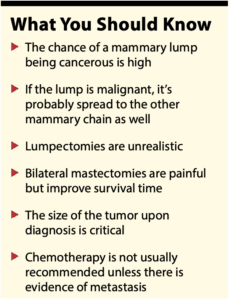 If chemotherapy is recommended for your cat, don’t worry. “The majority of cats tolerate the chemotherapy we prescribe very well and they have a great quality of life while undergoing treatment,” says Dr. Sylvester. “The most common side effect is weight loss and decreased appetite, but more significant gastrointestinal side effects such as vomiting and diarrhea are possible.
If chemotherapy is recommended for your cat, don’t worry. “The majority of cats tolerate the chemotherapy we prescribe very well and they have a great quality of life while undergoing treatment,” says Dr. Sylvester. “The most common side effect is weight loss and decreased appetite, but more significant gastrointestinal side effects such as vomiting and diarrhea are possible.
“Additionally,” continues Dr. Sylvester, “low white blood cell counts can predispose them to infection. Fortunately, less than 20% of cats get sick from chemotherapy and only about 5% need to stay in hospital due to the above-mentioned side effects.”
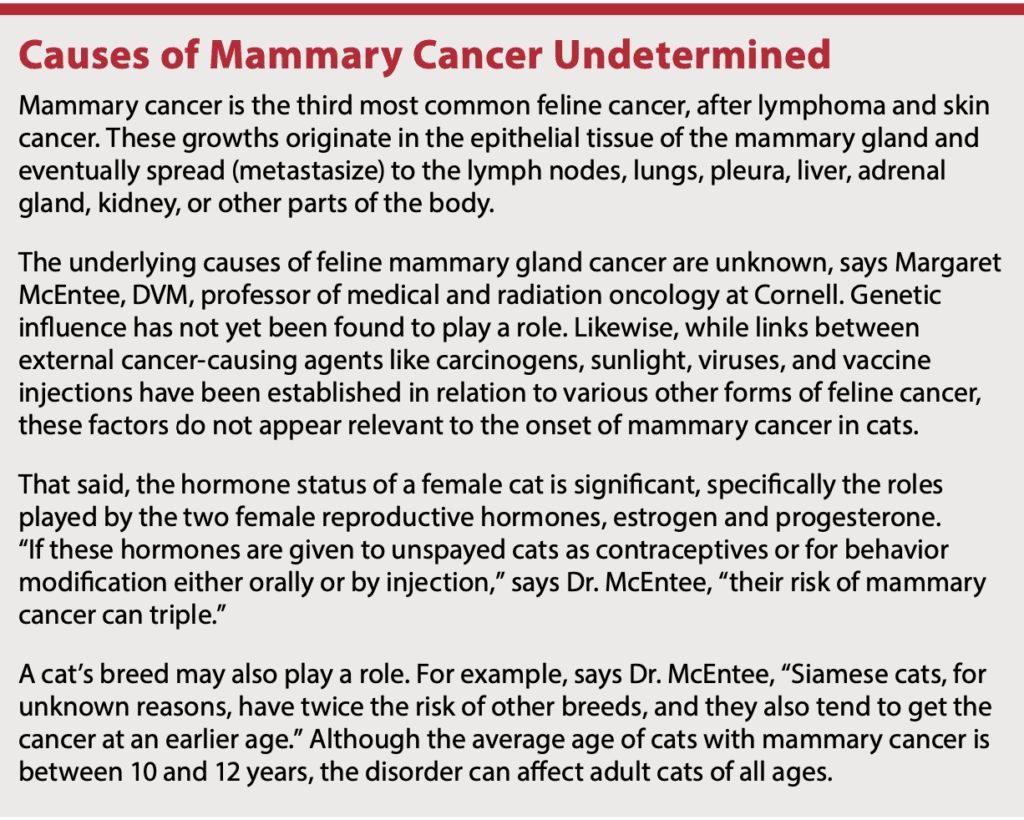
It’s not yet proven whether chemotherapy makes a difference for cats with advanced disease, but it appears to be worth a try since cats tolerate it well. Results from the study mentioned earlier suggest a beneficial effect on survival time for some cats treated with adjuvant chemotherapy, but more and larger prospective studies are needed to fully evaluate the benefit of chemotherapy for cats with advanced mammary carcinoma.
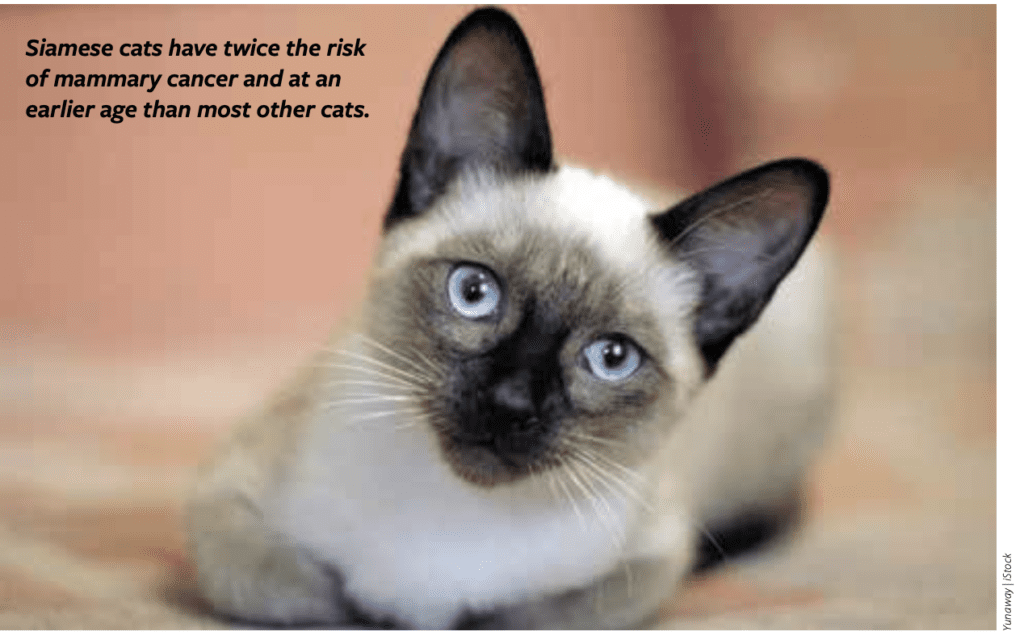
Bottom Line
Feline mammary cancer is almost always malignant and not likely to be cured. However, the sooner a breast tumor is discovered and aggressively treated, the better. The smaller the tumor is when it is found, the better.
Sadly, if cancer spread is discovered, the likelihood of a good outcome or long survival plummets. This may make you think twice about putting your cat through multiple invasive and painful procedures. But don’t despair. As in human medicine, many advancements have been made in palliative care for cats, with the goal of keeping your furry friend happy, comfortable, and with you for as long as possible.

